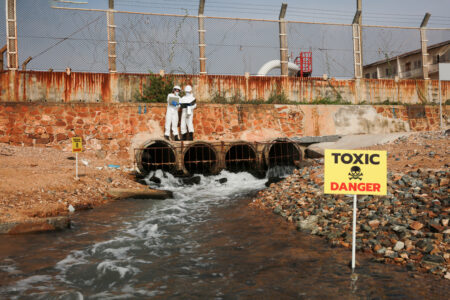
Share On Social!
From popcorn bags to pizza boxes, firefighting chemicals—that link to cancer development—contaminate food packages and seep into food.
Per- and polyfluoroalkyl substance (PFAS) contamination is a wide-spread problem. Researchers have discovered their presence in products, water, and food. They are also severely impacting the U.S. military and families.
Now PFAS in food packaging is an emerging threat, according to a recent report.
“Since the chemicals can migrate into food, and contaminate landfills and compost after disposal, the use of PFAS to treat food packaging can lead to unnecessary long-term exposure to harmful chemicals,” according to “Take Out Toxics: PFAS Chemicals in Food Packaging” by Safer Chemicals Healthy Families, Toxic-Free Future, and Mind the Store.
What Do We Know?
PFAS are a class of chemicals manufacturers use as fire-retardants. Despite their extensive use, some data has demonstrated these substances can be an initiator of cancer development.
PFAS are commonly used in food packaging for water and grease resistance.
Sandwich wrappers, french-fry boxes, and bakery bags have all been found to contain PFAS, according to the Take Out Toxics report.
“Between 2002 and 2016, the FDA approved 19 PFAS for use in food packaging and nearly half of the fast food wrappers collected in 2014 and 2015 had detectable PFAS,” the Environmental Working Group (EWG) writes in a June 2019 report.
The main problem with PFAS use on food packaging is chemical seepage into the food.
“Studies show that chemicals, including PFAS, can migrate into food from food packaging and food contact substances,” EWG writes.
It is also an issue because further research demonstrates how widespread PFAS exposure is.
“PFASs have been in production since the 1940s and are used in various products, including firefighting foam, nonstick cookware, food packaging, and stain- or water-resistant textiles,” according to a February study. “As of June 2018, the Organization for Economic Cooperation and Development had documented 4730 PFAS structures, including mixtures and several new groups of PFASs; however, it is unknown how many PFASs are in commerce. Since 1999, the Centers for Disease Control and Prevention has measured at least 12 PFASs in serum samples from participants in the National Health and Nutrition Examination Survey, indicating wide-spread exposure across the country.”
Are There Significant Risks?
Many Latinos in America find themselves trapped in food deserts, or areas that do not contain a grocery store within a 2-mile radius. They also tend to live in food swamps, which are food deserts that also have lots of unhealthy fast food options.
These families will face a lack of access to healthy options and can turn to rely on drive-through chains and packaged, processed items for their diet.
These products can contain the highest levels of PFAS contamination, according to the Take Out Toxics report.
Minority communities that deal with food-access inequity can also struggle with the development of other illnesses.
Problems such as heart disease, diabetes, hypertension, and obesity, are other worries—on top of PFAS exposure—impacting these groups, according to a 2016 study, published in the Journal of Immigrant and Minority Health.
“Fruit and vegetable consumption falls well below recommendations in much of the U.S., particularly among African American, Latino, low educational attainment, and low-income populations,” the study states. “Many neighborhoods with large minority populations are classified as food deserts, and lack full-service grocery stores, increasing the difficulty and expense of obtaining healthy foods.”
Who is Addressing this Problem?
PFAS contamination is an issue with limited understanding concerning scope and severity, according to Scott Faber of the EWG.
Thus, improving the level of understanding is important.
“The first step to addressing the PFAS contamination crisis is understanding where PFAS pollution is coming from and how far it has spread,” Faber said in a statement. “The fact that we know so little is a scandal. Much more needs to be done to address the crisis, but monitoring the scope of PFAS pollution will lay the groundwork for further progress.”
PFAS contamination also is on the minds of local, state, and federal officials.
In recent months, legislators in Anchorage, Alaska, Minnesota, and Washington state have passed comprehensive bills that ban PFAS use in consumer products. New Jersey state officials are also holding private companies, who have been large polluters, accountable for cleanup efforts.
At the federal level, Senators passed a bipartisan proposal through committee, which would expand the government’s role in motorizing the country’s wide-spread PFAS contamination.
While this is a significant initiative, Faber said there is still much work to be done.
“We need to address ongoing sources of PFAS pollution, including air and water discharges of PFAS and applications of PFAS-tainted sludge on farm fields,” Faber said. “We need to phase out the use of PFAS in food packaging and everyday products. We need to designate PFAS as a ‘hazardous substance’ to kickstart the cleanup process in the places with the worst contamination. But today’s compromise is an important first step.”
For those wanting to act in chemical, environmental exposure issues, speak up for climate science today!
Read more about environmental, chemical exposure!
Editor’s Note: This article is part of a collaboration between Salud America! and the Hoffman Toxicant-Induced Loss of Tolerance (TILT) program at UT Health- San Antonio. To find out if you are TILTed due to exposure to everyday foods, chemicals, or drugs, take a self-assessment or learn more about TILT.
By The Numbers
1
Quick Survey
Can help you find out how chemically sensitive you are



